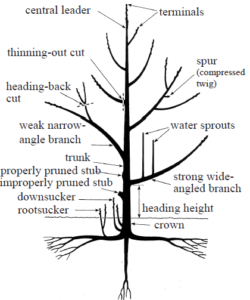Winter is the best time of year to prune deciduous ornamental trees and fruit trees. It is easier to see the entire form and structure when there are no leaves on the tree, and there is no danger in removing the food-producing leaves when the trees are dormant. Here are 10 things to keep in mind when incorporating winter pruning into your tree care plan!

1) The following deciduous ornamental trees should be pruned in the winter: Redbud, Dogwood, Styrax, Heptacodium, Birch, Beech, Linden, Katsura, Oak, Maple, Amelanchier, Halesia, Sourwood, Stewartia, Sycamore, Zelkova, and Willow.
2) The following fruit trees should be pruned in the winter: Crabapple, Apple, Cherry, Plum, Pear, Peach.
3) Deciduous ornamental trees should be pruned every 2-3 years, or yearly if they need to be kept a certain size, or if after substantial winter damage or excessive growth.
4) Fruit trees that are being grown for fruit production need to be pruned every year. If they are being grown for ornamental value, they can be pruned on the same schedule as the ornamental trees.
5) All diseased, dead, dying, or broken branches are removed first. Crossing branches, low growing branches and branches growing downward should be removed next.
6) Water sprouts are the branches that grow straight up from horizontal branches and suckers are the vertical branches that grow near the base of the trunk, out of the top of the tree or along the roots. Prune out suckers and water sprouts and any weak growth from last year’s pruning.
7) After the above branches are removed, then prune for form and function. Knowledge of the proper shape and growth habit of the tree that is being pruned is essential. Pruning for fruit production is based upon the species and variety of the fruit being grown.
8) There are 2 basic types of pruning cuts- a thinning cut and a heading cut. A thinning cut is always the preferred method and involves pruning a twig or branch back to another branch or the trunk. A heading cut involves pruning back to a bud or spur.
9) All cuts should be made just outside the healing collar of the branch, which is the raised bark ridge around the base of the branch where it meets the trunk or larger
branch. This will encourage proper healing of the cut. If a stub is left, healing will be difficult.
10) When starting out, most people err on the side of caution when pruning their trees, and are afraid to adversely affect or harm their tree when pruning. It is actually in the tree’s best interest to ‘get a haircut’ and will encourage the health and vitality of the tree, and proper healing and fruit production.
Proper pruning of your landscape trees is essential to the long-term health of your plants, and a properly trained professional arborist or trainee is indispensable in making that happen. Look for ISA certified individuals or Connecticut licensed arborists. If you reside in Fairfield, Litchfield, or Westchester Counties, don’t hesitate to contact Hoffman Landscapes with any winter pruning, tree health, or general landscape design/maintenance questions!


